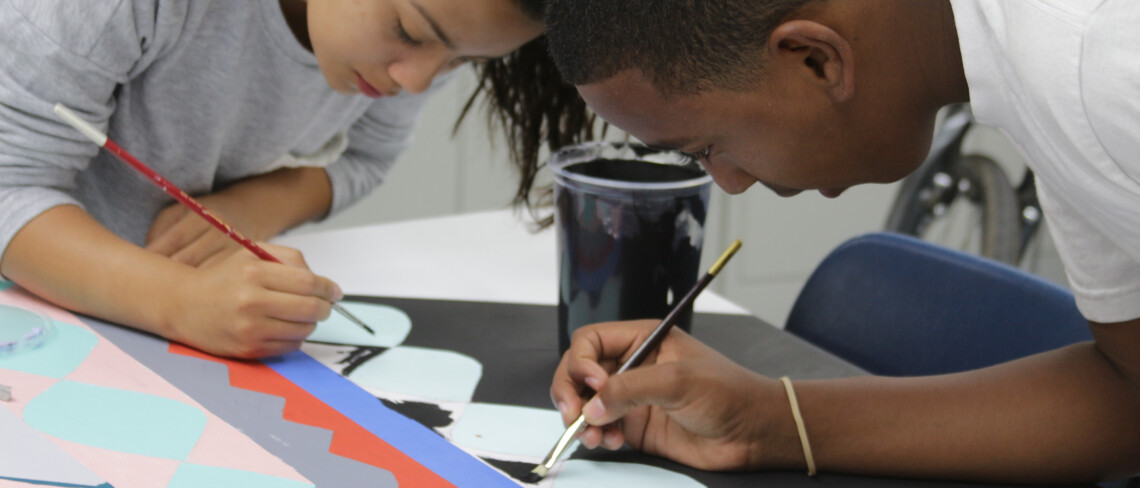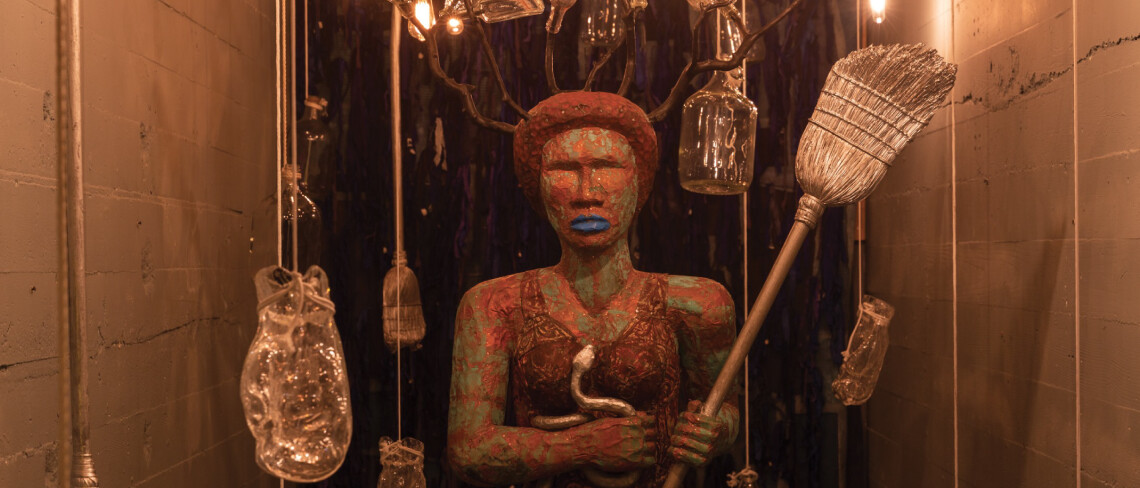About Armory Center for the Arts
Founded in 1989, Armory Center for the Arts is a nonprofit visual arts organization in Pasadena, California. We present exhibitions by forward-thinking contemporary artists and provide artist-led education programs for children, teens, and adults. Guided by a mission to nurture our community and its young people by creating, learning, and presenting art to advance equity and social justice, we envision joyful, healthy, and equitable communities shaped by imagination, creativity, and diverse voices.
A Hybrid Operating Model
The Armory is neither squarely an art museum nor an art school. We are a hybrid of both. Each side informs and complements the other. Our contemporary art exhibitions become a focal point for our education programs. Conversely, our education methods inform how learning happens in our galleries.
Centering Artists and Community
At the center of our hybrid model is a dedicated team of Armory Teaching Artists who design and lead all class offerings. Our faculty are accomplished artists with active studio practices who nurture their students' creative pursuits to develop a unique voice at their own pace. Armory education programs enhance social-emotional wellness, provide a powerful vehicle for self-expression, unite communities, and offer creative career pathways for young people.
Exhibitions as Teaching Tools
Though education is our priority, we also nurture our community by supporting contemporary artists and presenting exhibitions to advance social justice and advocate for a more equitable society. Exhibitions are a vital part of our mission, serving as powerful teaching tools. They tell important stories, encourage conversations about culture and modern life, spark creativity, and address past and present social issues that impact our communities.
Core Programs: Creating, Learning, and Presenting
Our exhibitions and education programs serve over 18,000 children, teens, and adults across LA County annually, with a particular emphasis on uplifting young people from historically under-resourced neighborhoods in Pasadena and the San Gabriel Valley. Armory core programs include:
- Year-round free art classes for children, teens, older adults, and families at parks, community centers, and juvenile justice centers across the region
- Rigorously researched exhibitions and related programs presented at no cost to the public, emphasizing contemporary artists whose work is socially relevant and often BIPOC-centered
- Sequential courses in public elementary school classrooms that merge visual arts with math and science
- Artist residencies embedding Armory Teaching Artists at local social service organizations
- Studio art classes for children, teens, and adults, designed and led by Armory Teaching Artists at our main facility
Armory History (1922-1989)

Opening day of the Junior Museum program at the Pasadena Art Institute, March 1, 1947.
The Pasadena Art Institute and The Junior Museum (1922-1953)
The Armory's Pasadena roots run deep. Our forebears, The Pasadena Art Institute's "Children's Museum" program, were among the first practitioners of artist-led museum youth education for contemporary visual arts on the West Coast.
Founded in 1922, The Pasadena Art Institute exhibited 19th-century American and European artists. The Institute also presented showcases of contemporary California artists. Located on the northeast corner of Colorado and Orange Grove Boulevards, the Institute operated out of the former summer residence of Reed College founders Amanda and Simeon Reed. In 1943, the Institute relocated to trustee Grace Nicholson's spectacular "Chinese Treasure House" on North Los Robles Avenue (now known as the USC Pacific Asia Museum). The Institute operated out of the Nicholson Building for 26 years.
Responding to post-war America's growing awareness of art's impact on children's emotional wellness, the Pasadena Junior League launched the "Junior Museum" program at the Pasadena Art Institute in 1947. The program allowed children to tour the Institute's acclaimed collections, meet artists, and experiment with materials. Teaching Artists encouraged children to express themselves freely, with the understanding that it was "okay to spill paint on the floor." The program, considered radical at the time, was an instant success. The Junior League ran the Children's Museum program for nine years before officially handing it off to the Art Institute in 1956.

Marcel Duchamp plays chess with Eve Babitz at the Pasadena Art Museum's Duchamp retrospective, 1963. Photo by Julian Wasser. ©1963, Julian Wasser.
The Pasadena Art Museum and the Children's Art Workshop (1953-1974)
The Institute changed its name to the Pasadena Art Museum (PAM) in 1953. It was the epicenter of the West Coast art scene during the '50s and '60s. Under the stewardship of legendary curator Walter Hopps, PAM was renowned for its groundbreaking exhibitions, including Marcel Duchamp's first US retrospective, which the artist famously attended. Around this time, the Junior Museum program was renamed the Children's Art Workshop. It was a national model for museum education that was replicated at other institutions across the country.
In 1969, Pasadena Art Museum moved into their custom-built, spectacular new facility on the northeast corner of Colorado and Orange Grove Boulevards and quickly fell into dire financial straits. In 1974, businessman and art collector Norton Simon agreed to absorb the museum's debts and, in exchange, acquired ownership of PAM's new building and its collection. Simon shuttered the building to renovate and install his vast collection of old masters and antiquities alongside PAM's modern works. During this period, Simon dissolved the Children's Art Workshop program. The museum reopened a year later as the Norton Simon Museum of Art.

Pasadena Art Workshops Teaching Artist Akeke Carroll, 1974
The Pasadena Art Workshops (1974-1989)
Following the Art Workshop's dissolution, a core group of supporters, staff, and faculty formed an independent nonprofit named The Pasadena Art Workshops in the summer of 1974. The new organization moved into Lincoln Elementary School — a surplus property of the Pasadena Unified School District (PUSD) at the corner of Lincoln Avenue and Orange Grove Boulevard. In its first year, the Workshops served over 3,500 children and adults with artist-led classes in visual arts, dance, music, and classes for special needs children. As interest grew, the Workshops were averaging 450 students per week.
The Workshops operated at the Lincoln School for six years until PUSD sold the property to the Federal Government to erect the Lincoln Avenue Post Office. In 1980, the Workshops relocated to an unused portion of PUSD's McKinley Elementary School on El Molino Avenue, where it operated for nearly a decade.

The Raymond Avenue California National Guard Armory, c.1988 (Photo by Susan Caldwell)
Armory Center for the Arts (1989-present)
In 1985, city officials contacted Pasadena Art Workshops leadership regarding the "under-used" California National Guard Armory building on Raymond Avenue. The 1932 Beaux-arts-styled former military facility, home to the Pasadena Badminton Club for over 50 years, had fallen into severe disrepair since interest in the sport waned and membership dwindled. The City offered the Armory building to the Workshops as part of a massive community redevelopment plan for the historic downtown district, now known as "Old Pasadena."
The following year, Pasadena Art Workshop leadership and a handful of supporters from CalTech's recently shuttered Baxter Art Gallery formed a new nonprofit, "The Armory Center for the Visual Arts," later shortened to the name we now use. The City granted this new organization a long-term "cashless" lease for the Raymond Avenue Armory. Both parties agreed that the organization would provide art exhibitions and art education services for the community equivalent to the fair market value of rent.
After raising over one million dollars for extensive renovations, Armory Center for the Arts opened to the public on November 2, 1989, where it still thrives today. Though the organization's name and locations have changed over the years, these three constants continue to inform our work: the exhibition of forward-thinking contemporary artists, the belief that artists are educators, and a commitment to protect equitable access to art tailored to our community's evolving needs.
Download the Free Book
Download your free PDF copy of Fifty Years: A Celebration of 50 Years of Art in Pasadena. This comprehensive history of the Armory's lineage and the role Pasadena played creating the West Coast's contemporary art scene in the mid-to-late 20th Century. We published this book in 1997 to mark the 50th Anniversary of the Children's Museum. The essays and historic photos in this publication are a unique record of the people and places that made Armory Center for the Arts possible.








